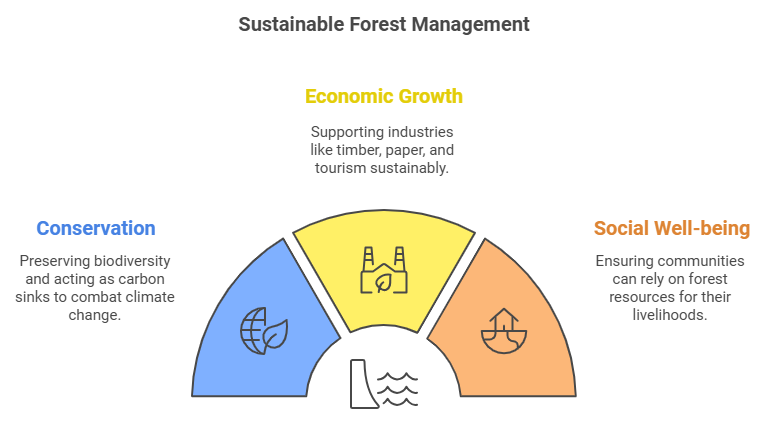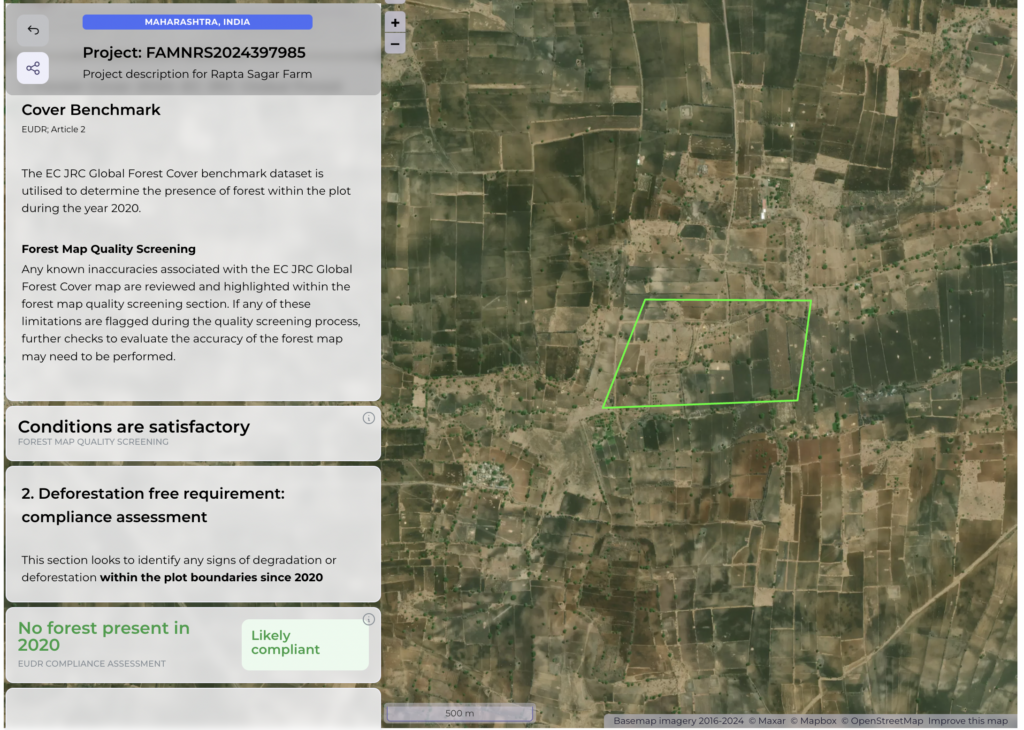Contact: +91 99725 24322 |
Menu
Menu
Quick summary: Learn how Sustainable Forest Management (SFM) helps businesses comply with the EU Deforestation Regulation (EUDR), ensuring responsible sourcing and protecting forests. Discover best practices and tools like TraceX’s EUDR software for efficient implementation.

Forests are often called the lungs of our planet, playing a critical role in absorbing carbon dioxide, supporting biodiversity, and maintaining the balance of our ecosystems. However, forests worldwide are under increasing threat due to deforestation driven by agriculture, logging, and other human activities. This widespread loss of forests doesn’t just harm the environment—it has ripple effects on our climate, wildlife, and even our economies. Sustainable forest management (SFM) is more important than ever as a powerful tool to address these challenges, ensuring forests can continue to provide vital resources while maintaining their long-term health.
“For in the true nature of things, if we rightly consider, every green tree is far more glorious than if it were made of gold and silver.”
– Martin Luther
This article will explore how sustainable forest management can be a game-changer for businesses striving to comply with the EUDR. We’ll dive into what sustainable forest management involves, how it aligns with the regulation’s goals, and the practical steps companies can take to ensure their supply chains are environmentally responsible.
Key Takeaways
The EU Deforestation Regulation (EUDR) is a new rule established by the European Union to combat deforestation worldwide. Simply put, the EUDR requires that certain goods sold in the EU do not contribute to deforestation anywhere in the world. This means that companies importing or selling products like beef, soy, coffee, cocoa, palm oil, rubber, and wood need to ensure these items are produced without destroying forests. The idea behind the EUDR is simple but powerful—stop deforestation at its source by regulating what enters the EU market.
To comply with the EUDR, companies need to take several key steps. First, they must trace the origin of their products and prove that they are not linked to deforestation. This often involves mapping their supply chains down to the specific plot of land where the products were grown or harvested. Businesses also need to provide “due diligence statements,” which are basically proof that their supply chains are clean and meet the EUDR’s standards.
The regulation sets its sights on ending deforestation by targeting high-risk commodities. This means that companies working with these products must ensure their production methods are deforestation-free. Failure to comply can lead to penalties, including fines and potential bans from the EU market.
The EUDR significantly impacts businesses, especially those in agriculture, forestry, and supply chain management. Companies working with products like coffee, soy, wood, or palm oil must now have full visibility into their supply chains. This can be challenging because supply chains often involve multiple players—farmers, suppliers, processors, and distributors—spread across different regions and countries.
For many businesses, this regulation presents a wake-up call to adopt better, more sustainable practices. It might mean switching to certified suppliers, implementing new traceability systems, or investing in technology that monitors and verifies the origins of their products. While these changes can be complex and may involve upfront costs, they also open doors to new opportunities. Companies that comply with the EUDR can differentiate themselves as leaders in sustainability, attract eco-conscious consumers, and ultimately contribute to the fight against global deforestation.
Sustainable Forest Management (SFM) is a way of managing forests that balances the need for resources with the need to protect and preserve forests for future generations. Think of it as maintaining a healthy forest ecosystem while allowing for the use of its resources, like timber, without harming the forest’s ability to continue providing these resources over time.
In Europe, the concept of SFM was defined by MCPFE as,
“The stewardship and use of forest lands in a way and at a rate that maintains their productivity, biodiversity, productivity, regeneration capacity, vitality and their potential to fulfil now and in the future relevant ecological, economic and social functions at local, national and global levels and that does not cause damage to other ecosystems.”
At its heart, SFM is built on a few key principles:
1. Environmental Protection: Ensuring that forests maintain their natural biodiversity, protect water cycles, and regulate climate.
2. Social Responsibility: Supporting the rights and livelihoods of local communities and indigenous people who depend on forests for their daily needs.
3. Economic Viability: Harvesting Forest resources in a way that supports long-term economic benefits without depleting the forest.
4. Monitoring and Accountability: Constantly monitoring forests to ensure they are being managed in a sustainable way, with regular assessments of health and growth.

Deforestation, or the large-scale removal of trees, is a huge problem. It leads to loss of biodiversity, contributes to climate change, and threatens the livelihoods of local communities. SFM is essential in addressing this because it helps us manage forests in a way that keeps them intact. Rather than clear-cutting trees for quick profit, SFM promotes harvesting in a way that allows forests to regenerate, ensuring that they stay healthy and resilient over time.
According to Earth.Org, Since 1990, the world has lost around 420 million hectares of forest due to deforestation. Although the pace of tree removal has shown a gradual decline in recent years, we continue to lose about 10 million hectares of forests annually, with every continent affected.
In simple terms, Sustainable Forest Management is like taking care of a garden—you pick the fruit, but you make sure the tree keeps growing and thriving. By focusing on SFM, we can help protect our forests and the many benefits they provide for both nature and people.
Implementing Sustainable Forest Management (SFM) isn’t always easy. There are several challenges that make it difficult for businesses and governments to adopt practices that protect our forests while also allowing for the use of resources like timber and paper.
Aligning Sustainable Forest Management (SFM) with EUDR (EU Deforestation Regulation) compliance is an important step for businesses aiming to meet European regulations while ensuring forests are protected and managed responsibly. The EUDR requires companies to ensure that the commodities they import into the EU (such as soy, palm oil, timber, coffee, cocoa, etc.) do not contribute to deforestation or forest degradation.
Businesses should start by developing and implementing clear sourcing policies that prioritize sustainability. These policies should specify that products must come from sustainably managed forests that meet the criteria of both SFM and EUDR. This means ensuring that the commodities are legally sourced and that they do not contribute to deforestation after the cut-off date established by the EUDR (December 31, 2020).
Collaboration with suppliers is key. Companies need to work closely with their suppliers to make sure they are aligned with sustainable forest management practices. This includes making sure that suppliers are aware of the EUDR and its requirements and encouraging them to adopt SFM practices as part of their operations.
One of the core requirements of EUDR is due diligence, which includes verifying that the supply chain is free from deforestation. This means businesses need to trace the origin of the products they source, ensuring that they come from regions that practice SFM. This can be achieved through robust mapping systems and traceability practices that document every step of the supply chain.
Certain certifications and tools can help businesses meet the requirements of both SFM and EUDR. These certifications prove that the forest management practices of suppliers are sustainable and that the products being sourced meet the legal and environmental standards set by the EU.
1. FSC (Forest Stewardship Council): FSC certification is one of the most recognized standards for sustainable forest management. It ensures that forests are responsibly managed to protect biodiversity, water resources, and local communities while also providing for the economic needs of the people who depend on them. Using FSC-certified products can help businesses meet EUDR criteria and show they are sourcing responsibly.
2. PEFC (Programme for the Endorsement of Forest Certification): PEFC is another internationally recognized certification that focuses on sustainable forest management. It is especially important for businesses that operate in regions where FSC certification may not be widespread. PEFC helps ensure that forests are managed sustainably and legally, making it a great tool for meeting both SFM and EUDR requirements.
Technology plays a huge role in ensuring that businesses can align SFM with EUDR compliance.
1. Satellite Monitoring: Satellite imagery can be used to monitor deforestation in real-time. By using satellite data, businesses can track whether their suppliers’ forests are being managed sustainably and if illegal deforestation is happening. This technology allows businesses to keep a close eye on their supply chains and ensure they are not linked to any deforestation or forest degradation.

2. Traceability Platforms: Digital traceability platforms, like the ones developed by companies such as TraceX, help businesses track the entire journey of their products. These platforms provide transparency, allowing businesses to verify the origin of their raw materials and ensure they are sustainably sourced. By using blockchain or other traceability technologies, companies can track products from forest to final consumer, which is crucial for meeting EUDR requirements.
3. Digital Due Diligence Systems: EUDR compliance requires businesses to perform due diligence, including gathering and verifying data about their supply chains. Digital tools that automate this process can help businesses collect and assess the necessary information more efficiently. With access to accurate data, companies can more easily prove that their supply chains are free from deforestation and meet the EU’s legal requirements.
Before you can begin implementing SFM practices, you need a clear understanding of your supply chain and where your materials come from. This is where TraceX’s EUDR software comes in handy.
Once you understand your supply chain, the next step is to develop and implement strategies for Sustainable Forest Management. TraceX’s EUDR software supports this process by providing the tools you need to ensure compliance and transparency.
SFM is an ongoing process, and TraceX’s EUDR software helps businesses stay on top of continuous monitoring, reporting, and improvement.
Incorporating Sustainable Forest Management (SFM) into your business practices is essential for aligning with the EU Deforestation Regulation (EUDR). By mapping your supply chain, setting clear sustainability goals, and continuously monitoring your sourcing, you ensure that your operations contribute to environmental conservation and uphold ethical business standards. With tools like TraceX’s EUDR software, businesses can seamlessly integrate SFM strategies, ensuring compliance while supporting sustainable practices across their entire supply chain. As global demand for sustainable sourcing grows, adopting these practices not only protects forests but also strengthens your brand’s commitment to environmental responsibility.
Sustainable Forest Management (SFM) refers to practices that ensure forests are managed in a way that maintains their biodiversity, productivity, and ecological balance while meeting the needs of present and future generations. It involves responsible sourcing, conservation, and minimizing environmental impacts.
TraceX’s EUDR software provides businesses with tools to map their supply chain, verify certifications like FSC and PEFC, and monitor deforestation risks in real-time. It ensures that companies can meet the EUDR’s due diligence requirements and source materials from responsibly managed forests.
Aligning with the EU Deforestation Regulation (EUDR) helps businesses avoid the legal and reputational risks associated with deforestation. It ensures compliance with European regulations, promotes sustainable sourcing practices, and supports global efforts to combat deforestation and climate change.
